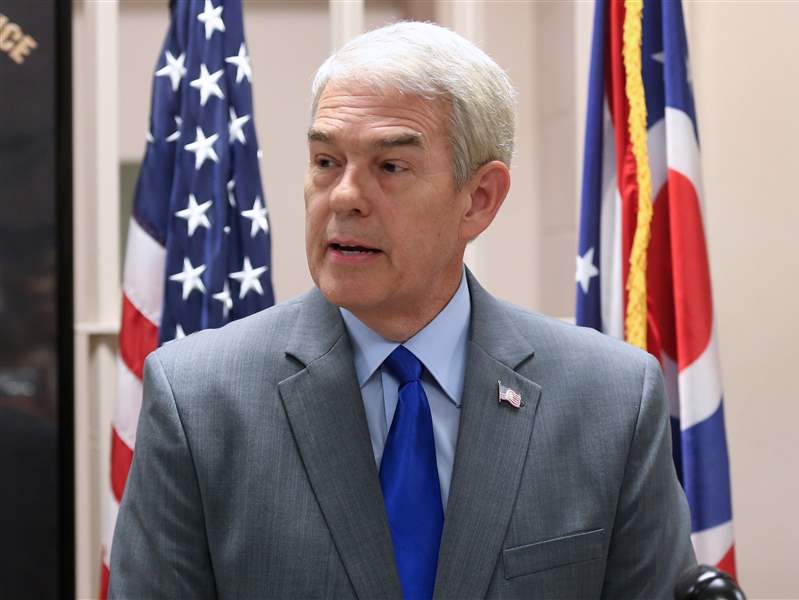
Proposed bills would fund runoff reduction efforts for Lake Erie
5/11/2018
State Senator Randy Gardner
The Blade
Buy This Image
COLUMBUS — As another toxic algae season approaches, state lawmakers are turning their attention to a pair of bills putting dollars behind Ohio’s efforts to dam the flow of agricultural nutrients into Lake Erie.

In this file photo, Sandra Frank holds a sign during a picket by the Advocates for a Clean Lake Erie outside of the federal courthouse in Toledo.
The proposed steps, however, don’t address stricter regulations on fertilizer pollution and wastewater treatment plants across the state sought by Gov. John Kasich’s administration. It has had trouble finding legislators willing to introduce the bill.
Only a handful of legislative session days are left before the General Assembly expects to recess for the summer, but state Sen. Randy Gardner (R., Bowling Green) said there seems to be some sense of urgency to shift into higher gear.
“Look at what’s changed in the last six to eight weeks,” he said. “Impairment designation. Judge Carr’s order. The U.S. EPA’s pending reaction to Judge Carr’s order. The early analysis of what [the National Oceanic and Atmospheric Administration] predicts for this year.
“On top of that we have the Ohio EPA admitting, kind of for the first time, that we haven’t made significant progress at all on the nutrient loading problem,” he said.
Hearings will begin Tuesday on a new bill with bipartisan support to finance efforts to meet the state’s more immediate commitment with Michigan and Ontario to reduce nutrient runoff by 40 percent by 2025.
Another measure takes a longer view, spending $1 billion, or $100 million a year for 10 years. That borrowing package would require voter approval.
“My front yard is the lake,” Rep. Steve Arndt (R., Port Clinton) said. “My backyard is the Portage River… I see the condition of that lake each and every day as well as the tributaries feeding it.”
He introduced the House versions of the proposals with Rep. John Patterson (D., Jefferson).
Ohio is about to go through another summer season of the green slime that annually coats the lake’s water surface, potentially threatens local water supplies, and frustrates sportsmen, environmentalists, boaters, and tourists.
NOAA’s recent first-of-the-year measurement of phosphorous runoff does not bode well for this year’s algal bloom climate, thanks to a wet April. U.S. District Court Judge James Carr recently admonished federal and state agencies for not doing enough to address lake water quality, and the Ohio Environmental Protection Agency has declared the waters of western Lake Erie to be an impaired watershed.
Ohio EPA Director Craig Butler said simply throwing more money at the problem isn’t the answer as he urged legislative action on his proposed regulatory changes.
“The time is now,” he said. “It will take time to implement these programs, and there will be a delay in terms of environmental changes. 2025 is right around the corner.”
The EPA wants to expand the maximum phosphorous discharge limit already applied by many wastewater treatment plants directly on the lake to other plants in the state. It also wants to change the definition of “agricultural pollution” to include fertilizers so the Department of Agriculture could mandate steps by farmers to curb runoff when a watershed is declared to be distressed.
“We will continue voluntary programs where we think they are effective, but we need to move to a regulatory approach until we meet our 2025 reduction goal,” Mr. Butler said. “We are not seeing positive movement.”
Mr. Arndt said the Ohio EPA’s proposals were seen as too broad and would have trouble passing this General Assembly.
Meanwhile, the Senate Finance Committee will hold its first hearing on the shorter-term measure sponsored by Mr. Gardner and Sen. Sean O’Brien (D., Cortland). The Clean Lake 2020 Plan would immediately appropriate $36 million as follows:
● Up to $20 million for the Department of Agriculture to help farmers in their currently voluntary efforts to reduce phosphorous runoff in the western basin watershed.
● $10 million more for the Healthy Lakes Initiative to invest in projects designed to help the state meet its legislatively mandated ban on open-lake dumping of sediment dredged from ports by 2020.
● $3.5 million to help county soil and water conservation districts with soil testing, nutrient management plans, and other conservation efforts.
● $2.56 million for lab space and monitoring equipment at the Ohio State Sea Grant and Stone Lab.
Separate resolutions in both chambers both propose a constitutional amendment to borrow $1 billion to help wastewater and water treatment plants, water quality research, and water resource management.
To some extent the measures put state money behind past mandates related to better manure and fertilizer management by farmers and restrictions on water treatment plants.
While the 2020 Plan focuses entirely on the Lake Erie watershed, the bond issue could fund projects across the state.
Contact Jim Provance at jprovance@theblade.com or 614-221-0496.